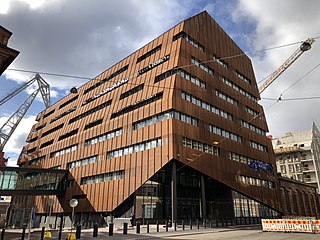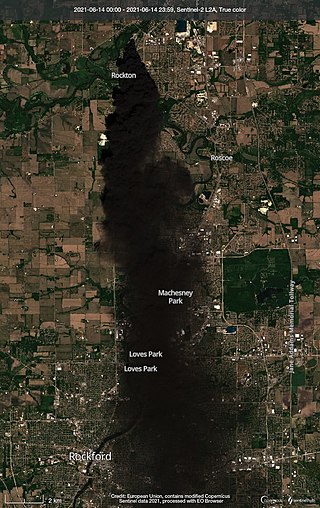
The Seveso disaster was an industrial accident that occurred around 12:37 pm on 10 July 1976, in a small chemical manufacturing plant approximately 20 kilometres (12 mi) north of Milan in the Lombardy region of Italy. It resulted in the highest known exposure to 2,3,7,8-tetrachlorodibenzo-p-dioxin (TCDD) in residential populations, which gave rise to numerous scientific studies and standardized industrial safety regulations, including the European Union's Seveso III Directive. This accident was ranked eighth in a list of the worst man-made environmental disasters by Time magazine in 2010.

A safety data sheet (SDS), material safety data sheet (MSDS), or product safety data sheet (PSDS) is a document that lists information relating to occupational safety and health for the use of various substances and products. SDSs are a widely used system for cataloguing information on chemical species including chemical compounds and chemical mixtures. SDS information may include instructions for the safe use and potential hazards associated with a particular material or product, along with spill-handling procedures. The older MSDS formats could vary from source to source within a country depending on national requirements; however, the newer SDS format is internationally standardized.

Registration, Evaluation, Authorisation and Restriction of Chemicals (REACH) is a European Union regulation dating from 18 December 2006. REACH addresses the production and use of chemical substances, and their potential impacts on both human health and the environment. Its 849 pages took seven years to pass, and it has been described as the most complex legislation in the Union's history and the most important in 20 years. It is the strictest law to date regulating chemical substances and will affect industries throughout the world. REACH entered into force on 1 June 2007, with a phased implementation over the next decade. The regulation also established the European Chemicals Agency, which manages the technical, scientific and administrative aspects of REACH.

The Dangerous Substances Directive was one of the main European Union laws concerning chemical safety, until its full replacement by the new regulation CLP Regulation (2008), starting in 2016. It was made under Article 100 of the Treaty of Rome. By agreement, it is also applicable in the EEA, and compliance with the directive will ensure compliance with the relevant Swiss laws. The Directive ceased to be in force on 31 May 2015 and was repealed by Regulation (EC) No 1272/2008 of the European Parliament and of the Council of 16 December 2008 on classification, labelling and packaging of substances and mixtures, amending and repealing Directives 67/548/EEC and 1999/45/EC, and amending Regulation (EC) No 1907/2006.
A chemical accident is the unintentional release of one or more hazardous chemicals, which could harm human health and the environment. Such events include fires, explosions, and release of toxic materials that may cause people illness, injury, or disability. Chemical accidents can be caused for example by natural disasters, human error, or deliberate acts for personal gain. Chemical accidents are generally understood to be industrial-scale ones, often with important offsite consequences. Unintended exposure to chemicals that occur at smaller work sites, as well as in private premises during everyday activities are usually not referred to as chemical accidents.
The Principles of Good Laboratory Practice (GLP) are guidelines for managing non-clinical health and environmental studies effectively. They cover how studies are planned, conducted, recorded, and reported. These principles define roles and responsibilities within test facilities, set standards for facilities and equipment, emphasize the use of standard procedures, and require proper documentation and record-keeping. Overall, GLP ensures studies are conducted responsibly and produce reliable results for regulatory purposes globally.

The European Chemicals Agency is an agency of the European Union working for the safe use of chemicals. It manages the technical and administrative aspects of the implementation of the European Union regulation called Registration, Evaluation, Authorisation and Restriction of Chemicals (REACH). ECHA is the driving force among regulatory authorities in implementing the EU's chemicals legislation. ECHA has to ascertain that companies comply with the legislation, advances the safe use of chemicals, provides information on chemicals and addresses chemicals of concern. It is located in Helsinki, Finland. ECHA is an independent and mature regulatory agency established by REACH. It is not a subsidiary entity of the European Commission.

The Globally Harmonized System of Classification and Labelling of Chemicals (GHS) is an internationally agreed-upon standard managed by the United Nations that was set up to replace the assortment of hazardous material classification and labelling schemes previously used around the world. Core elements of the GHS include standardized hazard testing criteria, universal warning pictograms, and safety data sheets which provide users of dangerous goods relevant information with consistent organization. The system acts as a complement to the UN numbered system of regulated hazardous material transport. Implementation is managed through the UN Secretariat. Although adoption has taken time, as of 2017, the system has been enacted to significant extents in most major countries of the world. This includes the European Union, which has implemented the United Nations' GHS into EU law as the CLP Regulation, and United States Occupational Safety and Health Administration standards.

The Control of Major Accident Hazards Regulations 2015 (COMAH) are the enforcing regulations within the United Kingdom of the Seveso III Directive devised in Brussels following the Seveso disaster. They are applicable to any establishment storing or otherwise handling large quantities of industrial chemicals of a hazardous nature. Types of establishments include chemical warehousing, chemical production facilities and some distributors.

Toy safety is the practice of ensuring that toys, especially those made for children, are safe, usually through the application of set safety standards. In many countries, commercial toys must be able to pass safety tests in order to be sold. In the U.S., some toys must meet national standards, while other toys may not have to meet a defined safety standard. In countries where standards exist, they exist in order to prevent accidents, but there have still been some high-profile product recalls after such problems have occurred. The danger is often not due to faulty design; usage and chance both play a role in injury and death incidents as well.
The European Chemicals Bureau (ECB) was the focal point for the data and assessment procedure on dangerous chemicals within the European Union (EU). The ECB was located in Ispra, Italy, within the Joint Research Centre (JRC) of the European Commission. In 2008 the ECB completed its mandate. Some of its activities were taken over by the European Chemicals Agency (ECHA); others remained within the Joint Research Centre. The history of the ECB has been published as a JRC technical report.

Council Directive 96/82/EC of 9 December 1996 on the control of major-accident hazards involving dangerous substances is a European Union law aimed at improving the safety of sites containing large quantities of dangerous substances. It is also known as the Seveso II Directive, after the Seveso disaster. It replaced the Seveso Directive and was in turn modified by the Seveso III directive (2012/18/EU).

The CLP Regulation is a European Union regulation from 2008, which aligns the European Union system of classification, labelling and packaging of chemical substances and mixtures to the Globally Harmonised System (GHS). It is expected to facilitate global trade and the harmonised communication of hazard information of chemicals and to promote regulatory efficiency. It complements the 2006 Registration, Evaluation, Authorisation and Restriction of Chemicals (REACH) Regulation and replaces an older system contained in the Dangerous Substances Directive (67/548/EEC) and the Dangerous Preparations Directive (1999/45/EC).
The Lubrizol Corporation is an American provider of specialty chemicals for the transportation, industrial and consumer markets. These products include additives for engine oils and other transportation-related fluids, additives for industrial lubricants, and additives for gasoline and diesel fuel. In addition, Lubrizol makes ingredients and additives for personal care products, pharmaceuticals and medical devices, specialty materials, including plastics technology, and coatings in the form of specialty resins and additives.
Hazard statements form part of the Globally Harmonized System of Classification and Labelling of Chemicals (GHS). They are intended to form a set of standardized phrases about the hazards of chemical substances and mixtures that can be translated into different languages. As such, they serve the same purpose as the well-known R-phrases, which they are intended to replace.

Directive 82/501/EC was a European Union law aimed at improving the safety of sites containing large quantities of dangerous substances. It is also known as the Seveso Directive, after the Seveso disaster. It was superseded by the Seveso II Directive and then Seveso III directive.
Directive 2012/18/EU or the Seveso-III Directive is a European Union directive aimed at controlling major chemical accident hazards. Seveso-III is implemented in national legislation and is enforced by national chemical safety authorities.
On 14 January 2020, there was a major explosion at the Chemical Industries of Ethylene Oxide (IQOXE) site in Tarragona, Catalonia, Spain. Three people died, although none of the fatalities were on-site, and seven people were injured because of the explosion.

On June 14, 2021, a maintenance accident at the Chemtool Incorporated manufacturing plant in Rockton, Illinois, triggered a chemical fire that lasted four days and injured two emergency workers. Portions of the village, located north of Rockford near the Illinois-Wisconsin state line, were subject to a mandatory evacuation as a result of the fire. The fire was not contained until June 16, with the evacuations lasting until June 18.








